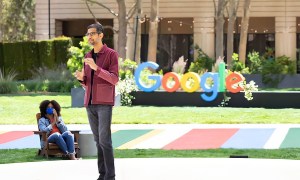
During today’s Google I/O event, the company gave us a quick teaser of what we can expect from its next revolutionary smartphone: The Pixel 7.
Although the focus was primarily on the Pixel products that are coming now — the Pixel 6a, Pixel Watch, and Pixel Buds Pro — Google also wants to make sure it’s whetting our appetites for the next big entry in its smartphone lineup.
While it’s not launching until later this year, we’d already heard enough to know not to expect any significant design changes, so today’s teaser didn’t include any real surprises. The Pixel 7 that Google showed off looks nearly indistinguishable from the Pixel 6, suggesting that Google has settled on this design as the look for its smartphones.
However, that doesn’t mean that Google isn’t enhancing the design in some exciting ways. At today’s event, it shared that the rear of the Pixel 7 and Pixel 7 Pro will move to a 100% recycled aluminum finish across the entire rear casing, including the camera bar. The polished and aluminum glass design promises to deliver an even classier look for Google’s flagship smartphone.

As expected, the Pixel 7 will be powered by Google’s next-generation Tensor chip, the second version of Google’s own silicon that builds on the original Tensor introduced with the Pixel 6. While this is being referred to as the “Tensor 2,” Google hasn’t announced its name just yet. The company did offer up that the Pixel 7 Pro will set a new standard for photography, performance, and design thanks to the powerful new chip that will power more heavy artificial intelligence processing for photography and video.
There have also been some indications that the Google Pixel 7 could adopt an under-display selfie camera for the first time, but the leaked renders we’ve seen have cast some doubt on that. Google didn’t mention this when it teased the new Pixel 7 at today’s event, and it conspicuously avoided showing us any images of the front of the Pixel 7.
The new Pixel 7 and Pixel 7 Pro will ship with Android 13 standard. Google confirmed that it will arrive this fall, but hasn’t shared any pricing or other details on it just yet, so we’ll have to wait and see what else it has up its sleeve for its next major smartphone release.

